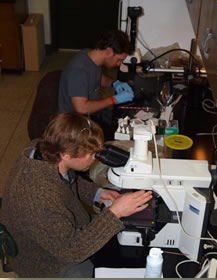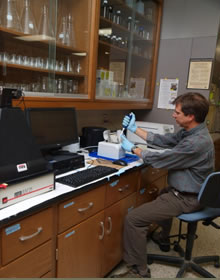Cytogenetics and Molecular Biology
go.ncsu.edu/readext?476038
en Español / em Português
El inglés es el idioma de control de esta página. En la medida en que haya algún conflicto entre la traducción al inglés y la traducción, el inglés prevalece.
Al hacer clic en el enlace de traducción se activa un servicio de traducción gratuito para convertir la página al español. Al igual que con cualquier traducción por Internet, la conversión no es sensible al contexto y puede que no traduzca el texto en su significado original. NC State Extension no garantiza la exactitud del texto traducido. Por favor, tenga en cuenta que algunas aplicaciones y/o servicios pueden no funcionar como se espera cuando se traducen.
Português
Inglês é o idioma de controle desta página. Na medida que haja algum conflito entre o texto original em Inglês e a tradução, o Inglês prevalece.
Ao clicar no link de tradução, um serviço gratuito de tradução será ativado para converter a página para o Português. Como em qualquer tradução pela internet, a conversão não é sensivel ao contexto e pode não ocorrer a tradução para o significado orginal. O serviço de Extensão da Carolina do Norte (NC State Extension) não garante a exatidão do texto traduzido. Por favor, observe que algumas funções ou serviços podem não funcionar como esperado após a tradução.
English
English is the controlling language of this page. To the extent there is any conflict between the English text and the translation, English controls.
Clicking on the translation link activates a free translation service to convert the page to Spanish. As with any Internet translation, the conversion is not context-sensitive and may not translate the text to its original meaning. NC State Extension does not guarantee the accuracy of the translated text. Please note that some applications and/or services may not function as expected when translated.
Collapse ▲

Fundamental research on chromosome numbers, ploidy levels, genome sizes, reproductive biology, phylogeny, hybrid verification, molecular markers, and DNA fingerprinting provides critical information for developing more efficient and effective plant breeding programs and insights into evolutionary relationships. Facilities at the Mountain Crop Improvement Lab include UV and laser flow cytometry, PCR capabilities, and fluorescent microscopy. Additional support for these activities has come from the North Carolina Biotechnology Center and the American Rhododendron Society.
For more information see:
- Nix, J., T.G. Ranney, N.P. Lynch, and H. Chen. 2024. Flow Cytometry for Estimating Plant Genome Size: Revisiting Assumptions, Sources of Variation, Reference Standards, and Best Practices. J. Amer. Soc. Hort. Sci., 149(3): 131-141. https://doi.org/10.21273/JASHS05376-24
- Maren, N.A., D.H. Touchell, T.G. Ranney, H. Ashrafi, M.B. Whitfield, and M. Chinn. 2020. Biomass yields, cytogenetics, fertility, and compositional analyses of novel bioenergy grass hybrids (Tripidium spp.). Global Change Biology Bioenergy. https://doi.org/10.1111/GCBB.12676.
- Ranney, T.G., T.H. Thomasson, K. Neill, N.P. Lynch, and M. Weathington. 2018. Ploidy, Relative Genome Size, and Inheritance of Spotted Foliage in Aucuba Species (Garryaceae). HortScience 53(9):1271–1274.
- Ranney, T.G.,C.F. Ryan, L.E. Deans, N.P. Lynch. 2018. Cytogenetics and Genome Size Evolution in Illicium. HortScience 53(5):620-623.
- Gillooly, D.A. and T.G. Ranney. 2015. Genome sizes and ploidy levels in the genus Kalmia. HortScience 50(10):1426-1428.
- Parris, J.K., T.G. Ranney, H.T. Knap, and W.V. Baird. 2010. Ploidy levels, relative genome sizes, and base pair composition in magnolia. J. Amer. Soc. Hort. Sci. 135(6):533-547. (JASHS cover).
- Rounsaville, T.J. and T.G. Ranney. 2010. Ploidy levels and genome sizes of Berberis L. and Mahonia Nutt. species, hybrids, and cultivars. Hortscience 45(7):1029-1033.
- Jones, J.R. and T.G. Ranney. 2009. Fertility of neoppolyploid Rhododendron and occurrence of unreduced gametes in triploid cultivars. J. Amer. Rhododendron Soc. 63(3): 131-135.
- Palmer, I.E., T.G. Ranney, N.P. Lynch, and R.E. Bir. 2009. Crossability, cytogenetics, and reproductive pathways in Rudbeckia subgenus Rudbeckia. Hortscience 44(1):44-48.
- Jones, J.R., T.G. Ranney, and T.A. Eaker. 2008. A novel method for inducing polyploidy in Rhododendron seedlings. J. Amer. Rhododendron Soc. 62(3):130-135.
- Zhou, W., T. Gibbons, L. Goetsch, B. Hall, T.G. Ranney, and R. Miller. 2008. Rhododendron colemanii: A new species of deciduous azalea (Rhododendron section Pentanthera; Ericaceae) from the Coastal Plain of Alabama and Georgia. J. Amer. Rhododendron Soc. 62(2):72-78.
- Jones, J.R., T.G. Ranney, N.P. Lynch, and S.L. Krebs. 2007. Ploidy levels and relative genome sizes of diverse species, hybrids, and cultivars of rhododendron. J. Amer. Rhododendron Soc. 61(4):220-227.
- Ranney, T.G., N.P. Lynch, P.R. Fantz, and P. Cappiello. 2007. Clarifying taxonomy and nomenclature of Fothergilla (Hamamelidaceae) cultivars and hybrids. HortScience 42(3):470-473. (HortScience cover).
- Contreras, R.N., T.G. Ranney, S.R. Milla-Lewis, and G.C. Yencho. 2007. Investigating parentage and hybridity of three azaleodendrons using AFLP analysis. HortScience 42(3):740-743.
- Contreras, R.N., T.G. Ranney, and S.P. Tallury. 2007. Reproductive behavior of diploid and allotetraploid Rhododendron L. ‘Fragrant Affinity’. HortScience 42(1):31-34.


